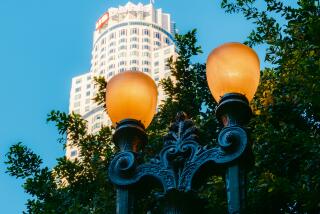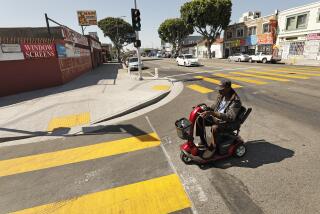Shedding Some Light on a Glaring Problem : High-pressure lamps mar astronomers’ view
- Share via
Some wheels just have to be reinvented to keep them turning.
The question of high-pressure sodium street lights vs. low-pressure sodium street lights is a case in point. After years of debate on the public safety, economics and scientific advantages of the two types of lights, astronomers from the Palomar and Mt. Laguna observatories were able to persuade the city of San Diego to switch to low-pressure sodium lights, which allow for better viewing of the night sky. Since then, the county and the cities of Escondido, Vista, Poway and San Marcos have done the same.
The evidence in favor of the yellow-cast, low-pressure lights seems even stronger today. The city of San Diego estimates that low-pressure sodium lights save $500,000 a year in electricity. And law enforcement agencies have not found a detectable difference in crime in neighborhoods with low-pressure lights.
Yet the same questions keep resurfacing. There was a proposal in the city of San Diego last year to convert some lights in high-crime areas back to high-pressure sodium.
And, in Oceanside, which is working on a municipal lighting ordinance, city staff members want to exempt street lights from the low-pressure sodium requirement.
The principal concern is whether low-pressure sodium lights are adequate deterrents to crime. The lights’ yellow cast washes out virtually all color, rendering most objects as shades of gray. So the clothing or cars of criminal suspects are harder to identify. The lights also appear dimmer to many people, although lighting experts say that, watt for watt, low-pressure sodium lights give off as much light as their whiter high-pressure cousins.
The arguments in favor of the low-sodium lights outweighed the disadvantages in 1985, and they still do.
Saving on electricity speaks for itself. And energy savings translate into less air pollution as well as lower electric bills.
The scientific advantages are less obvious to the non-scientist city dweller, who asks how much harm would be caused by a few high-pressure lights in limited areas, even if the neighborhood benefit is mostly psychological.
Understandably, the astronomers at California Institute of Technology, the operator of Palomar, and San Diego State University, which runs Mt. Laguna, view the question from a purist perspective. Any exemptions to the lighting ordinance open the door to other exemptions and more white light from Earth to compete with the pinpoints of light from far reaches of the universe.
Given the number of outdoor lights that will never be converted and the added light from population growth, the astronomers’ argument makes sense.
San Diego County benefits economically and intellectually from a thriving and growing scientific research community. Given the lights’ energy savings and their apparent lack of effect on crime, local governments would be wise to nurture that industry.
More to Read
Sign up for Essential California
The most important California stories and recommendations in your inbox every morning.
You may occasionally receive promotional content from the Los Angeles Times.










